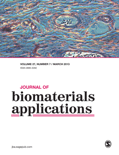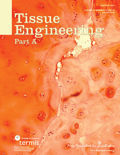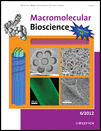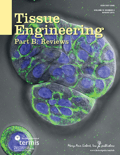
Bio-Design and Manufacturing
Scope & Guideline
Empowering Innovation at the Intersection of Biology and Manufacturing
Introduction
Aims and Scopes
- 3D Bioprinting and Biofabrication:
This area explores various methods and technologies for 3D bioprinting, including the development of bioinks, scaffold design, and the creation of complex tissues and organs for research and therapeutic applications. - Material Innovation for Biomedical Applications:
Research focuses on innovative materials such as hydrogels, nanocomposites, and biopolymers that enhance the functionality and biocompatibility of medical devices and tissue engineering scaffolds. - Microfluidics and Organ-on-a-Chip Technologies:
This scope investigates microfluidic systems and organ-on-a-chip platforms that mimic physiological conditions for drug testing, disease modeling, and the study of cellular interactions. - Wearable and Implantable Devices:
The journal covers the design and development of wearable biosensors, implantable devices, and smart bioelectronics that monitor health parameters or deliver therapeutic agents. - Regenerative Medicine and Tissue Engineering:
Research in this area emphasizes the application of biofabrication techniques for tissue regeneration, focusing on scaffolds, cell delivery systems, and the integration of biological cues. - Sustainable and Eco-friendly Manufacturing Practices:
A growing emphasis on sustainability in bio-design and manufacturing, including the use of recyclable materials, energy-efficient processes, and eco-friendly practices in biomedical manufacturing.
Trending and Emerging
- Smart Bioelectronics and Wearable Sensors:
There is a significant rise in research on smart bioelectronics and flexible wearable sensors that monitor physiological signals in real-time, reflecting a growing interest in personalized medicine and health monitoring. - Advanced Biomaterials and Bioinks:
Emerging studies are increasingly focused on developing novel biomaterials and bioinks that enhance the viability, functionality, and integration of bioprinted constructs in tissue engineering. - Microphysiological Systems and Organ-on-a-Chip Models:
Research on microphysiological systems, including organ-on-a-chip technologies, is expanding rapidly, driven by the need for better drug testing models that replicate human biology. - 4D Printing and Responsive Materials:
There is a burgeoning interest in 4D printing technologies that incorporate time as a dimension, allowing for the creation of materials that can change shape or function in response to environmental stimuli. - Integration of AI and Machine Learning in Bio-Design:
The application of AI and machine learning to optimize design processes, predict outcomes, and enhance the efficiency of bio-manufacturing practices is becoming increasingly prominent.
Declining or Waning
- Traditional Manufacturing Techniques:
There is a noticeable decrease in research focused on conventional manufacturing methods for biomedical applications, as the field shifts towards more advanced techniques like 3D printing and bioprinting. - Basic Biomedical Research Without Fabrication:
Papers that concentrate solely on basic biological studies without a direct application to bio-design or manufacturing are becoming less common, reflecting a trend towards more integrated research. - Pharmaceutical Applications of Bioprinting:
While bioprinting is still a key focus, specific applications related to drug development and delivery through bioprinted systems have decreased, as the journal pivots towards more innovative and diverse applications. - Non-biomimetic Approaches:
Research that does not incorporate biomimetic principles in design and manufacturing is waning, as the emphasis on biologically inspired designs gains traction.
Similar Journals

JOURNAL OF BIOMATERIALS APPLICATIONS
Fostering innovation in biomaterials and tissue engineering.JOURNAL OF BIOMATERIALS APPLICATIONS, published by SAGE PUBLICATIONS LTD, serves as a pivotal platform for the dissemination of cutting-edge research in the field of biomaterials and biomedical engineering. With an ISSN of 0885-3282 and an E-ISSN of 1530-8022, this journal has been a respected venue for scholarly communication since its inception in 1986. Aiming to provide comprehensive insights into the applications of biomaterials, this journal publishes high-quality articles that explore innovative materials and methodologies, thereby fostering advancements in medical technology and tissue engineering. The journal consistently ranks in the third quartile (Q3) for both Biomaterials and Biomedical Engineering categories, strengthening its position among the noteworthy academic resources available today. With a dedicated readership comprising researchers, industry professionals, and students, JOURNAL OF BIOMATERIALS APPLICATIONS plays a vital role in supporting knowledge exchange and scientific progress within these dynamic fields.

Tissue Engineering Part A
Bridging Research and Clinical ExcellenceTissue Engineering Part A is a prestigious peer-reviewed journal published by MARY ANN LIEBERT, INC that focuses on innovative research and advancements within the field of tissue engineering and regenerative medicine. Since its inception in 2008, this journal has played a critical role in disseminating cutting-edge findings that bridge the gap between laboratory research and clinical application, underscoring its significance in the scientific community. With a diverse scope encompassing biochemistry, bioengineering, biomaterials, and biomedical engineering, the journal ranks notably in the Scopus database, holding a Q2 quartile status across multiple categories, thus reflecting its high impact on ongoing research and professional practice. For researchers, professionals, and students, Tissue Engineering Part A serves as an invaluable resource, offering insights into the latest methodologies and breakthroughs that drive the future of healthcare and therapeutic strategies. While primarily a subscription-based journal, it ensures that vital research is accessible to a broad audience of scientists and engineers committed to advancing the life sciences.

Progress in Biomedical Engineering
Bridging disciplines to revolutionize healthcare outcomes.Progress in Biomedical Engineering, published by IOP Publishing Ltd, is a premier open-access journal that serves as a vital platform for the dissemination of innovative research in the field of biomedical engineering. With an impressive Q1 classification in the Biomedical Engineering category for 2023, this journal has established itself as a significant contributor to the advancement of engineering solutions that improve healthcare outcomes. Recognized for its high-quality and impactful publications, it ranks 51st out of 303 in its field on Scopus, placing it in the 83rd percentile. The journal aims to foster interdisciplinary collaboration and introduce pioneering methodologies and technologies that bridge the gap between engineering and medicine. By providing a pathway for rapid communication of fundamental and applied research, Progress in Biomedical Engineering is dedicated to shaping the future of healthcare technology. Access to its content ensures that researchers, professionals, and students remain at the forefront of biomedical innovation.

MACROMOLECULAR BIOSCIENCE
Driving Discovery in Polymers and BiotechnologyMACROMOLECULAR BIOSCIENCE, published by WILEY-V C H VERLAG GMBH, is a leading journal in the fields of bioengineering, biomaterials, biotechnology, materials chemistry, and polymers and plastics. With a convergence of scientific inquiry since its inception in 2001, the journal has established itself as a vital resource for researchers and professionals exploring the interface of molecular sciences and biosystems. It boasts impressive Scopus rankings, including Q1 status in multiple categories, reflecting its significant contribution to advancing knowledge and innovation in the polymer and biomaterials domains. While the journal does not currently offer open access options, its rigorous peer-review process ensures the publication of high-quality research that fuels academic discourse. Positioned in Weinheim, Germany, MACROMOLECULAR BIOSCIENCE aims to bridge theoretical understanding with practical applications, making it an essential reference for students, academics, and industry practitioners dedicated to the evolving landscape of macromolecular bioscience.

Tissue Engineering Part B-Reviews
Elevating Knowledge in Biochemical and Biomedical Engineering.Tissue Engineering Part B-Reviews is a premier academic journal published by MARY ANN LIEBERT, INC, focusing on the interdisciplinary field of tissue engineering and regenerative medicine. With an impressive impact factor that places it in the Q1 category across multiple relevant fields—including Biochemistry, Bioengineering, Biomaterials, and Biomedical Engineering—this journal provides a vital platform for researchers and professionals to disseminate cutting-edge findings and comprehensive reviews. Covering a vast scope from 2008 to 2024, the journal is committed to advancing knowledge in the application of engineering principles to biological tissues, making it an indispensable resource for those at the forefront of biomedical innovation. While the journal does not currently offer open access options, its rigorous peer review process ensures high-quality contributions that are essential for academic and practical advancements. The journal's rankings in Scopus reflect its significance, catering to a diverse audience of students, researchers, and practitioners seeking the latest insights in this dynamic field.

Biomedical Engineering-Biomedizinische Technik
Advancing Biomedical Innovation for a Healthier TomorrowBiomedical Engineering-Biomedizinische Technik, published by WALTER DE GRUYTER GMBH, serves as a pivotal platform for advancing knowledge in the field of biomedical engineering and medicine since its inception in 1956. With an ISSN of 0013-5585 and an E-ISSN of 1862-278X, this peer-reviewed journal offers accessible insights into innovative research and technological advancements that are reshaping healthcare practices and biomedical applications. Although rated in the Q3 category for both Biomedical Engineering and Miscellaneous Medicine in 2023, the journal's impact factor and growing reputation demonstrate its vital role in fostering academic dialogue and collaboration. The journal is based in Germany, while its scope encompasses a diverse range of topics, thus bridging the gap between engineering and medical disciplines. Researchers, professionals, and students alike are encouraged to engage with the content that not only highlights contemporary challenges but also presents groundbreaking solutions in biomedical technology.

APL Bioengineering
Connecting Minds, Elevating Bioengineering InnovationsAPL Bioengineering is a premier open-access journal published by AIP Publishing, dedicated to advancing the field of bioengineering and its interdisciplinary applications. Established in 2017, this journal serves as a vital platform for researchers, professionals, and students interested in the critical intersections of bioengineering, biomaterials, biomedical engineering, and biophysics. With an impressive impact factor and consistent rankings in the Q1 category across multiple domains, including biochemistry and materials science, APL Bioengineering has positioned itself among the top journals in its field. The journal aims to publish innovative original research, comprehensive reviews, and insightful case studies that further the understanding and application of bioengineering principles. Since its inception, APL Bioengineering has fostered a community of thought leaders, providing open access to ensure broad dissemination of knowledge and advancements that underpin the future of biomedical innovation.

Advanced Healthcare Materials
Innovating for a Healthier TomorrowAdvanced Healthcare Materials, published by WILEY, is a leading journal in the interdisciplinary fields of biomaterials, biomedical engineering, and pharmaceutical science. With its ISSN 2192-2640 and E-ISSN 2192-2659, the journal provides a platform for innovative research that encompasses the design, fabrication, and application of advanced materials in healthcare settings. Recognized for its high impact, it boasts a Q1 ranking in several categories, including a notable rank of #7/183 in Pharmaceutical Science and 14/137 in Biomaterials according to Scopus rankings. This reflects the journal’s commitment to publishing cutting-edge studies that push the boundaries of science and technology in medicine. Although it operates under a subscription model, articles published in this journal significantly impact the global research community and play a crucial role in the advancement of healthcare technologies. With a publication history from 2012 to 2024, Advanced Healthcare Materials remains an essential resource for researchers, professionals, and students engaged in the groundbreaking intersections of materials science and healthcare.

BIO-MEDICAL MATERIALS AND ENGINEERING
Exploring the future of biomedical materials.BIO-MEDICAL MATERIALS AND ENGINEERING, published by IOS PRESS, serves as a vital platform for advancing the fields of biomaterials and biomedical engineering. With its ISSN 0959-2989 and E-ISSN 1878-3619, the journal has been consistently disseminating high-quality research since its inception in 1991, covering a diverse range of studies on the development and application of biomedical materials. Although currently classified in the Q4 quartile in several categories including biomaterials and biomedical engineering, the journal aims to appeal to a broad audience of researchers and professionals, fostering collaboration and innovation in translating new materials into clinical practice. Located in the Netherlands, it emphasizes the importance of interdisciplinary approaches and provides a forum for new ideas and findings that could significantly impact healthcare solutions. While not an open-access journal, it provides various access options to maximize the reach and engagement of its research. Researchers, practitioners, and students alike will find valuable insights and comprehensive studies within its pages, contributing to the continued evolution of biomedical sciences.

Biomaterials Advances
Empowering Discoveries in Biomaterials and BeyondBiomaterials Advances is a premier journal published by Elsevier, dedicated to the rapidly evolving field of biomaterials. Established in the United Kingdom, this open-access journal aims to disseminate high-quality, peer-reviewed research that explores innovative biomaterial designs and their applications in bioengineering and biomedical engineering. With an impressive 2023 impact factor reflected in its Q1 rankings across multiple categories—including Bioengineering, Biomaterials, and Biomedical Engineering—Biomaterials Advances stands out as a critical platform for scholars and practitioners faced with advancing technologies and methodologies in the realm of materials science. Covering a broad range of topics, from biocompatibility to tissue engineering, this journal provides an inclusive forum for researchers seeking to contribute to the field. Its Scopus rankings further affirm its position as a leading resource, with notable standings in Biomedical Engineering (Rank #13), Biomaterials (Rank #8), and Bioengineering (Rank #11), all within the top percentiles. Researchers and students alike are encouraged to contribute and engage with the latest findings and innovations in biomaterials through this valuable publication.